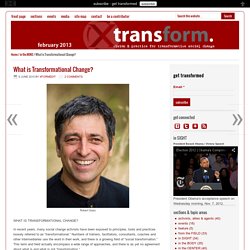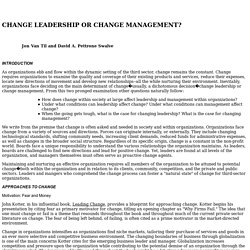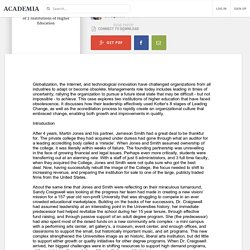

Leverage John Kotter's 'Dual Operating System' To Accelerate Change In Large Organizations. Tebr mar apr 2012 delivering transformational change. What is Transformational Change? Robert Gass In recent years, many social change activists have been exposed to principles, tools and practices loosely referred to as “transformational.”

Numbers of trainers, facilitators, consultants, coaches and other intermediaries use the word in their work, and there is a growing field of “social transformation.” This term and field actually encompass a wide range of approaches, and there is as yet no agreement about what is and what is not “transformation.” This brief paper is an attempt to initiate conversation about what our various efforts might have in common.
It is useful to think of transformational change as profound, fundamental and irreversible. Transformation is an approach, a philosophy and a methodology. Transformational change is holistic Transformational change is a systems approach, deriving its power by attending equally to hearts & minds (the inner life of human beings), human behavior, and the social systems and structures in which they exist. Written By Robert Gass. Change Activation Toolkit overviewTBO3a. Change. Change. CHANGE MANAGEMENT IN THE NTPS Better Practice Guide FINAL. I. As organizations ebb and flow within the dynamic setting of the third sector, change remains the constant.

Change requires organizations to examine the quality and coverage of their existing products and services, reduce their expenses, locate new directions of movement and develop new relationships--all the while nurturing their environment. Inevitably, organizations face deciding on the main determinant of changeusually, a dichotomous decisionchange leadership or change management. From this two pronged examination other questions naturally follow: We write from the premise that change is often asked and needed in society and within organizations. Organizations face change from a variety of sources and directions. Maintaining and nurturing an effective organization requires all members of the organization to be attuned to potential changeboth within the organization and in relation to its clients, community, competition, and the private and public sectors.
Three Types of Change Management Models. According to an article in Forbes, Change Management Guru is the world’s oldest profession.

Almost everyone has a few theories about change management. While there are many change management models, most companies will choose at least one of the following three models to operate under: 1. Lewin’s Change Management Model 2. McKinsey 7-S Model 3. Lewin’s Change Management Model This change management model was created in the 1950s by psychologist Kurt Lewin. 1. 2. 3. Kavanagh article exploring. Tda little book of change. Accelerate by John Kotter. Leading%20Change%20FIP%2012 2004.
Tda little book of change. Appreciative%20inquiry. A%20Process%20Model%20of%20Org%20Change%20in%20Cutural%20Context prR7. StanleyG 06 SustainableLeadership. Seizing Opportunities The dual operating system: Key characteristics The Dual Operating System. 19322 Press HE Collection AOM%202015%20(00000002) Leadership competency development guide change leadership. AROB00050. Leading Change. Making change work. Ohr 85505. Flanagan TurningShip. 131 Flynn and Ugyel Diagnostic Tool ANZAM 2013. Leadingchange. Leading-change-through-small-practice.
Ecp0803358. Leading Change: The Examples of 2 Institutions of Higher Education. Globalization, the Internet, and technological innovation have challenged organizations from allindustries to adapt or become obsolete.

Managements role today includes leading in times of uncertainty, rallying the organization to pursue a future ideal state that may be difficult - but notimpossible - to achieve. This case explores two institutions of higher education that have facedobsolescence. It discusses how their leadership effectively used Kotter’s 8 stages of LeadingChange, as well as the accreditation process to rapidly create an organizational culture thatembraced change, enabling both growth and improvements in quality. Introduction After 4 years, Martin Jones and his partner, Jameson Smith had a great deal to be thankfulfor. The private college they had acquired under duress had gone through what an auditor for a leading accrediting body called a ‘miracle’.
Leadingchange. EntSol Whitepaper Change Management Theories Methodologies 0213 1. An Integrated Approach to Change Leadership Judith Skelton Green Simpson Scott. Sense urgency. Leadingchange. ChangeManagementweb. Pr1. ChangeManagementGuide FINAL. Paper020413. Url?sa=t&rct=j&q=&esrc=s&source=web&cd=40&cad=rja&uact=8&ved=0ahUKEwiwlsfSv5TKAhXCc44KHdQcBME4HhAWCEwwCQ&url=
GuideOrgChange. GuideOrgChange. Kotter-8-steps-ebook. Kotter-8-steps-ebook. Kotter 2012 paper hbr.org 2012 11 accelerate. 50.02.SenseUrgency. Accelerate Discussion Guide. Enabling Change Through Strategic Initiatives. Enabling Change Through Strategic Initiatives. Accelerate! Perhaps the greatest challenge business leaders face today is how to stay competitive amid constant turbulence and disruption.

Any company that has made it past the start-up stage is optimized for efficiency rather than for strategic agility—the ability to capitalize on opportunities and dodge threats with speed and assurance. I could give you 100 examples of companies that, like Borders and RIM, recognized the need for a big strategic move but couldn’t pull themselves together to make it and ended up sitting by as nimbler competitors ate their lunch. The examples always play out the same way: An organization that’s facing a real threat or eyeing a new opportunity tries—and fails—to cram through some sort of major transformation using a change process that worked in the past.
But the old ways of setting and implementing strategy are failing us. We can’t keep up with the pace of change, let alone get ahead of it. What to do, then? LeadingChangeKotter. Leadingchangekotter. 2.1%20Leading%20Change%20 %20Why%20Transformation%20Efforts%20Fail%20by%20JP%20Kotter. 15 1722011 successful change management. Applying kotter step process for leading change to digital transformation of an orthopedic surgical practice 2157 7420.1000129. Ugrd thesis2014 mgmt mourfield. Guiding Principles for Leading Change Guide vjune2012. ExecSummaries Heart of Change. John Kotter What Leaders Really Do HBR 2001.